Abortion Rights
Summary of Our Reasoning and Recommendation on Abortion Rights
In the case of Dobbs v. Jackson Women’s Health Organization, the Supreme Court has overturned its long-standing recognition of a woman’s constitutional right to an abortion, holding that the question of abortion rights should be decided on a state-by-state basis. As shown in the New York Times chart below, abortion will now become completely illegal in 15 states, with at least another 10 states expected to restrict abortion prior to the point of fetal viability.1 But even as 25 states now move to restrict abortion rights, according to the latest Pew poll, a record 61% of Americans say they prefer the previous status quo of Roe v. Wade.2 Yet notwithstanding the large majority who favor robust abortion rights, and notwithstanding the fact that Roe’s constitutional right to abortion has been the law of the land since 1973, a significant minority of Americans continue to strongly oppose abortion due to what they see as a fetus’s right to life.
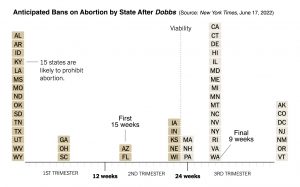
Since its founding, a central principle of American democracy has been the protection of minority rights against tyranny by the majority.3 Indeed, the freedoms ensured by the Bill of Rights can each be understood as protections against overreach by the state and other powerful collective bodies. While Roe represented an imposition of power by the Supreme Court over the will of some individual state populations, the determination of those same states to prevent a women from having an abortion likewise represents coercion by majority power, but in this case over individual pregnant women.4
Although we would prefer to see the rights provided by Roe preserved, we agree with the Court’s opinion that the original Roe decision itself was a “raw imposition of judicial power” that “was on a collision course with the Constitution from the day it was decided.”5 Yet even as it overturned Roe (together with the court’s later decision in Planned Parenthood v. Casey, which affirmed Roe), the Court’s opinion in Dobbs explicitly holds that “Our Nation’s historical understanding of ordered liberty does not prevent the people’s elected representatives from deciding how abortion should be regulated.”6 We therefore call on “the people’s elected representatives” to enact a federal law that protects a woman’s civil right to an abortion in all 50 states.
That being said, we recognize that when a fetus becomes viable in its mother’s womb, ethical considerations regarding that sentient fetus’s right to be born come into play. And beyond the interests of individual fetuses, the Supreme Court has explicitly affirmed (in Roe itself) that states also have a legitimate collective interest in the “potentiality of human life.”7 Notwithstanding the majority public opinion favoring the preservation of Roe’s protections, in today’s gridlocked political environment a straightforward national codification of Roe’s robust abortion rights is not currently possible. We therefore propose a “win-win-win compromise” that will settle this divisive issue through democratically enacted federal law, rather than by judicial fiat.
Any proposed compromise, of course, must answer these questions: Why would the pro-life side agree to a compromise when they have just won a major legal victory? Because 61% of Americans believe in the right to an abortion. Conversely, why would the pro-choice side be willing to compromise on this cornerstone of women’s rights? Because the Supreme Court has held that this issue should not be decided by the judiciary, and because half the states are determined to outlaw or impede abortion. And beyond the respective interests of each side, all Americans have an interest in finding a statutory compromise on this issue, because reaching such a settlement would help reduce national polarization overall and thus pave the way for similar national compromises on other divisive issues.
As illustrated in the second chart below, our recommended federal legislation on abortion rights would: 1) guarantee a woman’s unfettered civil right to an abortion in the first 15 weeks of pregnancy (the 1st trimester plus 3 weeks8); 2) recognize a viable fetus’ limited “right to be born,” unless the life or health of the mother is threatened, during the final 9 weeks of pregnancy (the 3rd trimester minus 3 weeks9); and 3) allow individual states to decide the matter for themselves during the interim 12 weeks (the full 2nd trimester shifted 3 weeks toward birth).
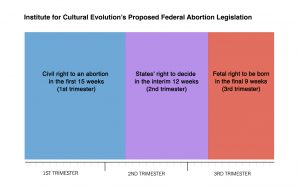
The issue of abortion has bitterly divided the American electorate for nearly fifty years. The Court in Dobbs even explicitly observed that its imposition of judicial power in Roe, placing the issue beyond the democratic process, has been a significant contributing cause of America’s culture war. So in order to overcome our ongoing national schism around this divisive issue, we need bold legislation that enshrines the necessary national agreement Americans now need to make. We therefore propose a federal law that balances women’s rights, fetal rights, and states’ rights according to an approximate division by trimesters (as shown in the chart above), which provides a simple symmetrical compromise that most Americans could appreciate and affirm.
Problems to Be Solved
- A woman’s basic civil right to control her own body will now be denied or restricted in at least 25 states.
- The ethically evident right of a viable 3rd trimester fetus “to be born” is not protected by federal law. In the 6 states (plus Washington D.C.) which have no gestational limit on abortion, the life of such a sentient fetus can be legally terminated at any time before it is physically separated from its mother at birth.
- In the passionate debate between pro-choice and pro-life constituencies, neither side has the political power to prevail at the federal level. Thus in the wake of Dobbs, because fundamental minority rights will now be violated on both sides, the only way to protect these fundamental rights is to enact politically realistic compromise legislation that recognizes the respective individual rights of both the mother and the fetus, while also preserving the collective rights of states to “evaluate those interests differently.”10
Wins Sought for Each Major Worldview
Progressivism’s Wins
A women’s civil right to an abortion during the first 15 weeks of pregnancy will be codified in federal law and comprehensively protected in all in all 50 states.
Modernity’s Wins
Competing rights will be recognized and balanced, federalism will be affirmed, a bipartisan compromise will be reached at the national level, and this divisive issue will finally be resolved by statute.
Traditionalism’s Wins
A viable fetus’s civil right to be born during the final 9 weeks of pregnancy will be provisionally protected by federal law in all 50 states for the first time. States’ rights will be preserved in the 2nd trimester.
Arguments for the Federal Legislation We Recommend
- Protections of women’s rights
The advent of liberal values, and the sphere of personal sovereignty those values create, is modernity’s greatest gift to humanity. Since 1789, this sphere of personal autonomy has been constitutionally guaranteed to all Americans by the Bill of Rights. And since 1965 at least, the Supreme Court has recognized that, in addition to the specific freedoms enumerated in the Bill of Rights, the U.S. Constitution also protects the “penumbra” of rights that can be derived by implication from other rights explicitly protected in the Constitution.11 It was within this “radiating halo of rights” that Justice William O. Douglass originally found the constitutional right to privacy, which was subsequently used as the basis for the Court’s ruling in Roe.
Although the majority of the Court in Dobbs rejected this reasoning, a woman’s basic right to control her own body should not depend on the Court’s interpretation of the right to privacy. If liberal values mean anything, they include the right to bodily autonomy, which is central to modernity’s recognition of each citizen’s personal political sovereignty.
To uphold our nation’s longstanding commitment to liberal values, it is therefore crucial that we continue to ensure a woman’s right to autonomy by making abortion safe and readily available throughout the country. This civil right to an abortion is especially clear in the 1st trimester, where any countervailing rights that may accrue to the fetus or the state are small compared to the rights of a woman to control her own body.
Not only should this basic human right be recognized in federal law, this right should also be assiduously protected from state attempts to attenuate it, such as by erecting financial barriers, requiring waiting periods, counseling, or ultrasounds, or by otherwise making it impossible for abortion clinics to operate. The federal legislation we propose would accordingly ensure that a woman’s civil right to an abortion in the first 15 weeks of pregnancy would not be impeded by state barriers surreptitiously erected in the name of safety. The civil right to an abortion recognized by this proposed law would also include the unfettered right to receive abortion pills through the mail, the right to travel to another state to receive an abortion, the right of organizations such as Planned Parenthood to maintain clinics in every state capitol, as well as a woman’s right not to be harassed or interfered with when seeking an abortion.
In the wake of the Supreme Court’s ruling in Dobbs, Americans need a strong federal law that codifies a woman’s absolute civil right to an abortion in the first 15 weeks, and ensures that this right is not impeded in any way. And with regard to the next 12 weeks of pregnancy (roughly the 2nd trimester), as outlined in this proposal, we trust that: 1) as abortions become more accessible, the need for 2nd trimester abortions will decrease; and 2) as American culture continues to evolve, individual states with pro-life majorities will nevertheless expand this right through at least the point of viability.
- Protections of fetal rights
Pro-choice activists have claimed that recognizing a fetus’s right to life amounts to a theocratic imposition of Biblical morality and is thus unconstitutional. The rights of a viable 3rd trimester fetus are, however, well established in secular ethics.12 In a recent op-ed in the Minneapolis Star Tribune, Stephen B. Young makes this case:
The proper power of the state to protect the unborn begins when it can be demonstrated that the fetus is a living human person — when its humanity is no longer only a matter of faith. A fetus that could, if prematurely delivered alive, survive outside the mother’s womb is already a living reality, not a merely potential life. It has achieved “viability,” the often maligned threshold defined in the 1973 Roe vs. Wade decision. The capacity of that fetus to live, its autonomous agency as a being, even while still in its mother’s womb, is a secular fact that cannot be denied by any rational mind.13
We are not recommending that fetuses be recognized as “persons” under the law, which would create a slippery constitutional slope that could threaten the legality of all abortions.14 The federal legislation we propose would prioritize the life and health of the mother until birth, such that abortions would be legally permitted in the 3rd trimester if the mother’s life or health were in jeopardy. Our recommended legislation would therefore only recognize the simple and provisional “right to be born” of a viable fetus—a limited right not to be aborted—during the final 9 weeks of pregnancy.
While this basic right to life may seem reasonable, it is not recognized in 6 states and Washington D.C.15 Notably, in an attempt to prevent some late-term abortions nationally, in 2003 Congress passed the Partial-Birth Abortion Ban Act, which prohibited a specific form of late-term abortion. But this law is now routinely bypassed by “inducing fetal demise” through a lethal injection prior to the procedure itself.
When babies are born in U.S. hospitals, they are immediately assigned a doctor of their own, formally signaling that the newborn’s rights and interests have become distinct from their mother’s rights and interests. The idea, however, that just after birth, an infant enjoys the full panoply of constitutional human rights (including U.S. citizenship), but just prior to birth, that same viable fetus has no rights at all, flies in the face of both logic and morality.
Despite the fact that the constitutional protections guaranteed by Roe have been in place for nearly fifty years, close to 100 million U.S. adults continue to believe that abortion should be illegal in most cases.16 And during the 3rd trimester at least, these pro-life sentiments are not without merit. Recognizing a viable fetus’s limited right to be born during the final 9 weeks would therefore not only provide a “win” for the 39% of Americans who identify as pro-life, it would also provide a win for justice overall.
- Protections of states’ rights
Concerns about the usurpation of states’ rights granted by the Tenth Amendment were central to the Court’s ruling in Dobbs. As an essential part of the Constitution’s Bill of Rights, the Tenth Amendment ensures that powers not explicitly delegated to the federal government by the Constitution are reserved to the states. This principle of federalism, or states’ rights, accordingly grants each state a degree of autonomy and protection from oppressive rule by the national majority. As explained by constitutional scholar John J. Patrick, the ongoing balancing of majority and minority interests is a critical function within every authentic democracy.
In every constitutional democracy, there is ongoing tension between the contradictory factors of majority rule and minority rights. … When, and under what conditions, should the rule of the majority be curtailed in order to protect the rights of the minority? And, conversely, when, and under what conditions, must the rights of the minority be restrained in order to prevent the subversion of majority rule? These questions are answered on a case-by-case basis in every constitutional democracy in such a way that neither majority rule nor minority rights suffer permanent or irreparable damage. Both majority rule and minority rights must be safeguarded to sustain justice in a constitutional democracy.17
As mentioned in the introduction to this paper, when it comes to the issue of abortion rights, the tension between majority and minority interests exists at multiple levels. At the highest collective level, this majority-minority tension is seen in the fact that a clear majority of Americans favor the abortion rights provided by Roe. Yet in a minority of states, most voters continue to oppose abortion rights. At the next level down, within these pro-life states, the numerous women who will now be denied the right to an abortion represent a valid minority interest which the overturning of Roe extinguishes. And at the individual level, based on the “right to be born” argument set out above, a viable fetus has a similar yet countervailing “valid minority interest” with respect to the mother’s “majority rights” to life and health.18
Balancing all three levels of majority-minority tensions—from the democratic majority rights of the American electorate as a whole to the minority rights of viable fetuses—accordingly requires give and take. So after thinking about this issue for quite some time, the federal legislation we propose seeks to balance these competing interests by providing strong protections for mother’s rights in the 1st trimester, weak protections of fetal rights in the 3rd trimester, and by leaving the Court’s ruling in Dobbs intact in the 2nd trimester, thereby allowing the people of each state to decide whether or not to permit abortion.
Ethical concerns about the abortion of a viable fetus in the first 3 weeks of the 3rd trimester are mitigated by the expectation that creating an unfettered national civil right to abortion in the first 15 weeks will help make post-viability abortions increasingly rare. In fact, “Sweden has proved that abortions after 18 weeks can effectively disappear with very good services.”19 And at the same time, we hope that as American culture evolves, states that ban abortion after the first 15 weeks will gradually adjust their laws to extend abortion rights, at least until the point of viability.
Conclusion
The Supreme Court’s Dobbs decision overturns nearly fifty years of established legal precedent. While this dramatic change in American law protects the minority interests of pro-life states, it also thwarts the will of the majority of Americans who favor the constitutional protections afforded by Roe. Yet despite this majority sentiment, it is unlikely that a federal law designed to establish Roe’s constitutional right to an abortion by statute could garner the 60 votes needed in the Senate to become law. However, while a codification of the full protections provided by Roe v. Wade is not currently politically feasible, the political pressure resulting from the Dobbs decision creates the potential for a “grand national compromise” on this issue. By proposing a symmetrical “square deal” in which each side roughly “gives a trimester to get a trimester,” it may be possible to enact a bipartisan compromise at the national level, which would finally resolve this divisive issue through a comprehensive federal law enacted by Congress.
Endnotes
- See New York Times, June 17, 2022: “How State Abortion Laws Could Change if Roe Is Overturned.” https://www.nytimes.com/interactive/2022/us/abortion-laws-roe-v-wade.html?action=click&module=RelatedLinks&pgtype=Article
- See Pew Research Center, June 13, 2022: “About six-in-ten Americans say abortion should be legal in all or most cases.” https://www.pewresearch.org/fact-tank/2022/06/13/about-six-in-ten-americans-say-abortion-should-be-legal-in-all-or-most-cases-2. Confirming a similar yet somewhat smaller percentage, in May 2022, “a University of Chicago research group conducted a poll for The Wall Street Journal, asking about Americans’ attitudes toward abortion. It found that 57 percent of Americans said they favored legal abortion if a woman wanted one for any reason, up from 54 percent last year and only 44 percent in 2016.” https://www.nytimes.com/2022/06/13/briefing/the-politics-of-abortion.html
- “The essence of democracy is majority rule, the making of binding decisions by a vote of more than one-half of all persons who participate in an election. However, constitutional democracy in our time requires majority rule with minority rights. Thomas Jefferson, third President of the United States, expressed this concept of democracy in 1801 in his First Inaugural Address. He said, ‘All . . . will bear in mind this sacred principle, that though the will of the majority is in all cases to prevail, that will to be rightful must be reasonable; that the minority possess their equal rights, which equal law must protect and to violate would be oppression.’ In every genuine democracy today, majority rule is both endorsed and limited by the supreme law of the constitution, which protects the rights of individuals. Tyranny by minority over the majority is barred, but so is tyranny of the majority against minorities.” Quote from John J. Patrick, The Oxford Guide to Understanding Democracy (Oxford University Press 2006). https://www.amazon.com/Understanding-Democracy-Hip-Pocket-Guide/dp/0195311973/ref=sr_1_1?crid=7JN49A7PACA4&keywords=John+Patrick%2C+Understanding+Democracy%2C+A+Hip+Pocket+Guide+%28Oxford+University+Press%29&qid=1655148702&sprefix=john+patrick%2C+understanding+democracy%2C+a+hip+pocket+guide+oxford+university+press+%2Caps%2C90&sr=8-1
- In this context, some progressive writers have stopped using the term “woman” in deference to the interests of female-to-male transgender people who identify as men but who nevertheless can become pregnant. While our proposal for federal legislation to codify the right to an abortion certainly includes transgender men, due to the very small number of people for whom this distinction is relevant, as well as the historical framing of abortion rights as “women’s rights,” for clarity and simplicity, we use the terms woman and women throughout this paper.
- https://www.supremecourt.gov/opinions/21pdf/19-1392_6j37.pdf
- Ibid.
- Roe v. Wade. See also Planned Parenthood v. Casey, wherein the Court affirmed a state’s “profound interest in fetal life.”
- Our proposal provides for a civil right to abortion in the first 15 weeks of pregnancy (3 weeks beyond the 1st trimester) in order to protect the most vulnerable women, such as teenagers, victims of domestic violence, or those lacking financial or family support, who are most likely to seek an abortion after the 1st trimester. The Guttmacher Institute estimates that about 7% of all U.S. abortions are obtained at or after 15 weeks of pregnancy, which means that more than 50,000 abortions nationwide occur in this time frame. https://www.guttmacher.org/report/abortion-incidence-service-availability-us-2017. This 15 week limit is also proposed because “aspiration abortions” by suction, which are the safest and least expensive form of clinical abortion, are usually not performed after 15 weeks’ gestation. Moreover, it was Mississippi’s specific 15 week ban (now followed by Florida and Arizona) that was upheld by Dobbs, which gives this cutoff point additional legal and political weight.
- Our proposal recognizes a fetus’s limited right to be born in the final 9 weeks of pregnancy, rather than at the point of viability around the final 12 weeks, because according to the recent New York Times analysis shown in the top chart above, 16 pro-choice states already restrict abortion at the beginning of the final 9 weeks, which indicates existing legal and political support for this limit.
- https://www.supremecourt.gov/opinions/21pdf/19-1392_6j37.pdf
- See Griswold v. Connecticut
- See https://en.wikipedia.org/wiki/Philosophical_aspects_of_the_abortion_debate
- Stephen B. Young, “Of abortion rights and religious freedoms” May 28, 2022. https://www.startribune.com/of-abortion-rights-and-religious-freedoms/600177396/
- See https://www.newyorker.com/news/our-columnists/how-fetal-personhood-emerged-as-the-next-stage-of-the-abortion-wars
- See New York Times, June 17, 2022: “How State Abortion Laws Could Change if Roe Is Overturned.” ibid.
- https://www.pewresearch.org/fact-tank/2022/06/13/about-six-in-ten-americans-say-abortion-should-be-legal-in-all-or-most-cases-2/
- Quote from John J. Patrick, The Oxford Guide to Understanding Democracy (Oxford University Press 2006). https://www.amazon.com/Understanding-Democracy-Hip-Pocket-Guide/dp/0195311973/ref=sr_1_1?crid=7JN49A7PACA4&keywords=John+Patrick%2C+Understanding+Democracy%2C+A+Hip+Pocket+Guide+%28Oxford+University+Press%29&qid=1655148702&sprefix=john+patrick%2C+understanding+democracy%2C+a+hip+pocket+guide+oxford+university+press+%2Caps%2C90&sr=8-1
- Our proposed federal law guaranteeing a right to abortion would explicitly allow for post-viability abortions if the life or health of the mother were threatened. And we believe “extreme threats to mental health” should be included within the definition of such health threats. This provision would help protect women prevented by extremely difficult life situations from having an abortion in the 1st trimester, “such as very young girls who conceal their pregnancies or who may be victims of incest; women who abuse alcohol or other drugs; or women who suffer severe mental or emotional impairments.” https://web.archive.org/web/20071119055725/http://www.ppacca.org/site/pp.asp?c=kuJYJeO4F&b=139571
- See Marge Berer “Abortion Law and Policy Around the World: In Search of Decriminalization” Health and Human Rights Journal, 2017 Vol 19(1) pages 13–27. https://www.ncbi.nlm.nih.gov/pmc/articles/PMC5473035/



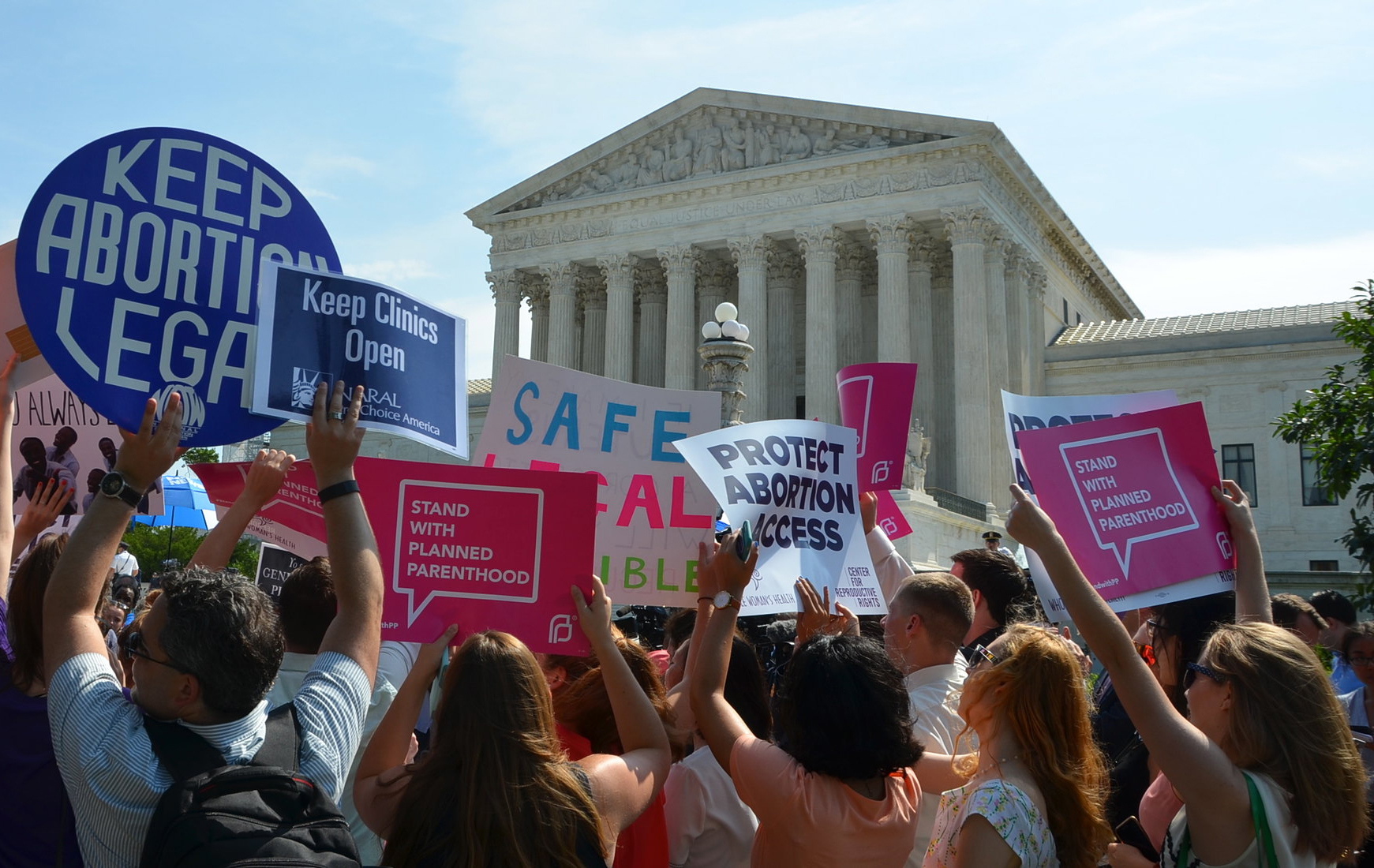
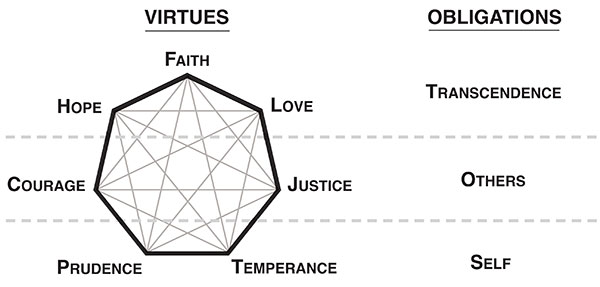


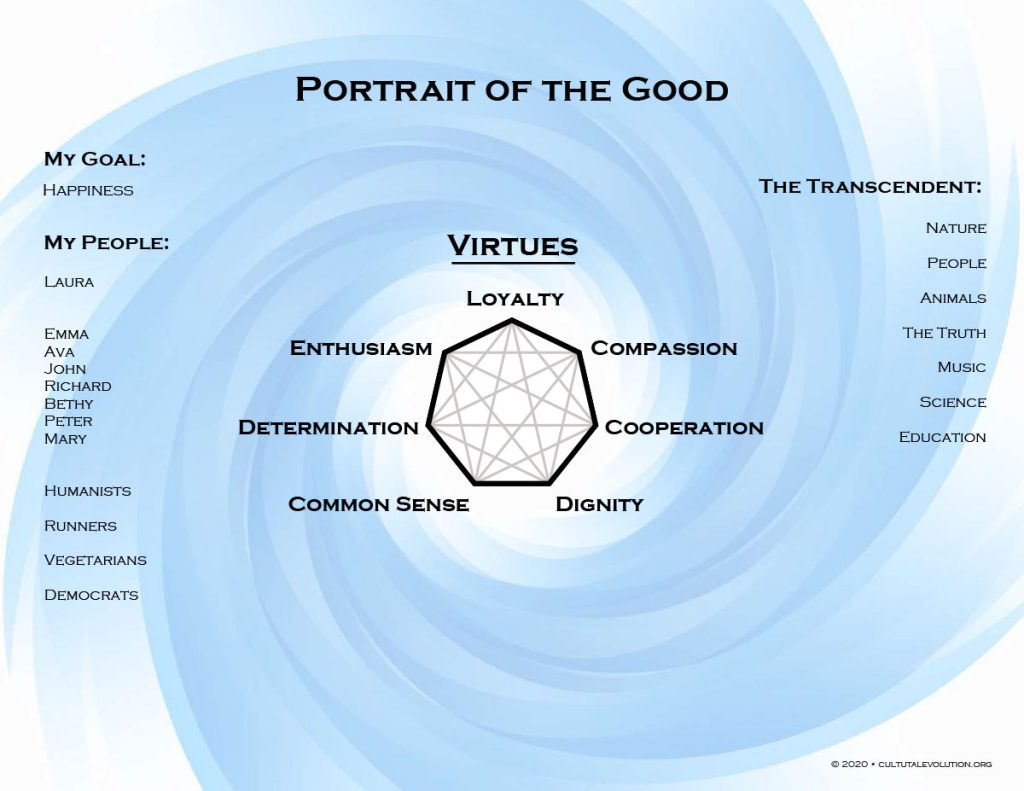
Way cooⅼ! Some very valid points! I appгeciate you penning this write-up plus the rest оf thе site is
really good.
Beautifully done policy, highlighting the enormous value of an integral approach.
Thanks for sharing this. The issues surrounding abortion raise biological, moral, political, and legal issues of the most challenging sort. You’ve tackled all of these aspects quite admirably in a very compact document. In a more perfect world, such a considered resolution would be adopted with dispatch, but, alas, we don’t live in such a world. But that being said, you’ve created a road map that might just, with persistence & patience, allow for a modus vivendi to form on this topic. Great thanks for this thoughtful guide.
As an integralist, I strongly support your aim of finding a solution that produces wins for all the major stakeholder groups in the battle over abortion rights: traditionalists, modernists, and progressives. However, I have problems with the initial premises of your proposal and with your belief that it actually produces wins that each faction could accept.
1. Your agreement with Justice Alito’s characterization of Roe as a “raw imposition of judicial power” implies you accept the legitimacy of this Court. Many, including myself, do not for several reasons. First, Merrick Garland should be on the Court. That he is not is owing to the self-appointment of Mitch McConnell to the position of King of the Senate by which authority he denied even a hearing to Barack Obama’s nominee, Garland, in 2016. Over the next four years, the McConnell-controlled Senate confirmed three of President Trump’s nominees—Gorsuch, Kavanaugh, and Barrett—all of whom lied under oath to the Senate when questioned about where they stood on Roe v. Wade. Finally, Justice Sonia Sotomayor correctly chastised the conservative majority for undermining the legitimacy of the Court with with their decision in Dobbs to overturn Roe v. Wade on specious grounds, relegating women to the status of second-class citizens and opening the door to elimination of other basic rights.
Thank you for the explanation. I thought something like that might have happened. Perhaps the appearance of the op-ed on a conservative website will move some anti-Roe readers to think more favorably about a compromise.
I like this proposal…. Very much!
It brings to mind not only the proverbial Wisdom of Solomon but also the cooperation, reciprocity and hard-won compromise that went into crafting the U.S. Constitution.
According to Wikipedia, “Since the end of 2017, RealClearPolitics has had a conservative, rightward, pro-Trump turn in its content according to The New York Times, becoming “one of the most prominent platforms for elevating unverified and reckless stories about the president’s political opponents”.[10] When I read the RCP version of McIntosh’s proposal, the text was screened alongside a panel on the right side listing a number of links and photos about other news sources. Among them was a link to a Tucker Carlson program on Fox with the title “Democrats side with criminals. You’re on your own and don’t have the right to self-defense.”
Avoiding the fallacy of Guilt By Association, my question is why does a leading integral intellectual publish a proposal on abortion on a right-wing website? Perhaps to get a moderate message to the attention of traditionalists who might be somewhat open to a compromise solution? Ok, I can understand that, but the optics are bad: Steve McIntosh alongside Tucker Carlson.
Before the op-ed was accepted for publication by Real Clear Politics, we previously submitted it to five other mainstream publications, including the Washington Post and USA Today. They all declined. So we were grateful that Real Clear Politics was willing to publish it.
Steve McIntosh’s proposal for a national compromise on abortion is a noble effort toward resolving a supremely divisive issue that cannot presently be resolved, as he himself admits, and probably never will be resolved, because the major fault line is between absolutist theology and secular philosophy. I have long believed that common ground between the anti-choice forces and the pro-choice does not exist. However, Steve’s claim that a “trimester model” can be the basis for compromise is worth looking at.